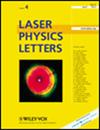通过双折射补偿实现 532 纳米波长腔内 Nd:YAG/LBO 激光器的功率缩放
IF 1.4
4区 物理与天体物理
Q3 OPTICS
引用次数: 0
摘要
我们报告了一种减少腔内倍频激光器中热双折射引起的偏振态变化影响的有效方法。该激光器由一个二极管侧泵浦 Nd:YAG 模块、一个声光调制器 Q 开关和一个用于在 532 nm 激光器中产生 SHG 的 LBO 晶体组成。由于 Nd:YAG 棒的端面呈凹形,其产生的热双折射对 SHG 效率的影响可通过在腔体中插入一个 λ/8 板来补偿。在 9 kHz 的重复频率下,532 nm 激光器的最大输出功率为 23.8 W,脉冲持续时间为 60 ns (FWHM),光束品质因数为 Mx2× My2 = 1.52 × 1.43。与使用 λ/4 板和不使用 λ/4 板的激光器相比,使用 λ/8 板的激光器的最大平均功率分别提高了 22.7% 和 66.4%,光束质量因数也相应得到了大幅提高。这种方法为激光器补偿热致双折射提供了一种新的解决方案。本文章由计算机程序翻译,如有差异,请以英文原文为准。
Power scaling of intra-cavity Nd:YAG/LBO laser at 532 nm by birefringence compensation
We report an effective method to reduce the impact of polarization state changes caused by thermal birefringence in intra-cavity frequency-doubled laser. The laser consists of a diode side pumped Nd:YAG module, an acousto-optic modulator Q-switch, and an LBO crystal used for SHG generation in 532 nm laser. The effect of thermal birefringence originated by the Nd:YAG rod with concave-shape end surfaces on SHG efficiency is compensated by the insertion of a λ /8 plate into the cavity. At the repetition frequency of 9 kHz, the 532 nm laser achieves a maximum output power of 23.8 W, a pulse duration of 60 ns (FWHM), and a beam quality factor of Mx
2
× My
2
= 1.52 × 1.43. Compared with the λ /4 plate and without plate, the maximum average power of the laser with the λ /8 plate has increased by 22.7% and 66.4%, respectively, the beam quality factor has also been greatly improved correspondingly. This method provides a new solution for lasers to compensate thermally induced birefringence.
求助全文
通过发布文献求助,成功后即可免费获取论文全文。
去求助
来源期刊

Laser Physics Letters
物理-仪器仪表
CiteScore
3.30
自引率
11.80%
发文量
174
审稿时长
2.4 months
期刊介绍:
Laser Physics Letters encompasses all aspects of laser physics sciences including, inter alia, spectroscopy, quantum electronics, quantum optics, quantum electrodynamics, nonlinear optics, atom optics, quantum computation, quantum information processing and storage, fiber optics and their applications in chemistry, biology, engineering and medicine.
The full list of subject areas covered is as follows:
-physics of lasers-
fibre optics and fibre lasers-
quantum optics and quantum information science-
ultrafast optics and strong-field physics-
nonlinear optics-
physics of cold trapped atoms-
laser methods in chemistry, biology, medicine and ecology-
laser spectroscopy-
novel laser materials and lasers-
optics of nanomaterials-
interaction of laser radiation with matter-
laser interaction with solids-
photonics
 求助内容:
求助内容: 应助结果提醒方式:
应助结果提醒方式:


